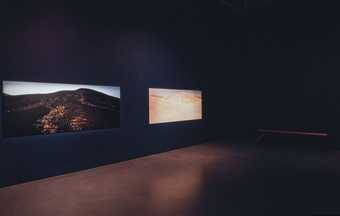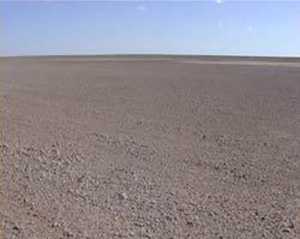Single Shot is a series of newly commissioned film and video works by artists and new talent. All the works are shot in one single take.
Inaugurating a series of stagings of the Single Shot pieces at a number of places across London, this special showcase at Tate Britain offers not only the largest single cross-section of the fifteen individual works but, in its imaginative deployment of diverse and unusual spaces, encapsulates something of the wider ambitions of the project as a whole.
Alongside dedicated moving-image galleries like Art Now Light Box, Single Shot brings film and video to parts of the building where work is seldom, if ever, displayed. Premiered in the Late at Tate Britain programme on 3 November, the featured Single Shot pieces continue to make an appearance for four weeks thereafter, radiating out across the length and breadth of the Millbank site. Presented as interventions among the collection or in overlooked corners of the main exhibition galleries, Single Shot also provides at-seat visual stimulation for customers of the Tate Britain café, as well as onboard entertainment for passengers travelling on the Tate Boat between the Tate Britain and Tate Modern.
The works are shown on a national tour of cinemas, galleries and other more unusual venues, and many of the works are available as free web downloads.
Single Shot is the first product of a major new collaboration between UK Film Council and Arts Council England.
Single Shot artists and films
George Barber, Automotive Action Painting
Observed from an overhead camera, a man stops by the roadside one morning and empties the contents of a number of large cans of paint over the tarmac. As the light rises, along with the level of traffic, the cars spread the paint along the surface of the road, creating an abstract smear of vibrant colour.
Clio Barnard, Dark Glass
Shot on a mobile phone, Clio Barnard’s Dark Glass is a taut micro-drama that visually recreates a spoken description of family photographs recalled under hypnosis. Although the recollection appears incredibly compelling, it also possesses an inherent instability, so that we are never quite sure what we’re hearing or seeing, something further emphasised by the unsteady nature of the image itself, which lends an apparitional quality to this apparent act of truth-telling.
Shane Davey, I’ve Been Single Too Long
Whether a declaration of yearning or an admission of an overheated imagination, the title of Shane Davey’s single-shot work offers an insight into the scene being played out before us. Rising from his bed, the listless male protagonist wanders through his house and into his hammock in the garden, oblivious, it seems, to the many young women – wearing only their underwear – lounging all around him.
Ben Dodd, Surprise
In this stylish short thriller with Hitchcockian overtones, a man lies lifeless on a bathroom floor, while above him looms the figure of a woman, a large knife lying at her feet. As the scene unfolds – running backwards in time – our surprise at what has happened is perhaps as great as those to whom it has.
Sean Dower, Automaton
Using a motion-control camera rig most often used in the production of special effects, Sean Dower takes the camera on a dynamic three-dimensional journey round a full-sized drum kit. As the camera weaves around the highly reflective black and chromed curves, it tracks the detail of a complex and shifting drum solo, in which both drummer (Steve Noble) and camera are locked together into a single resonant performance.
Ori Gersht, Pomegranate
In a carefully composed scene reminiscent of a Juan Sanchez Cotan sixteenth-century still life, a pomegranate fruit stands out from a muted, theatrical backdrop. After a few moments, this highly symbolic fruit is exploded by a high-velocity bullet; seeds spilling from its disintegrating carcass in extreme slow motion, and with an eerie and terrible beauty.
Matthew Grinter, Tea Leaves
Doing the rounds of the tables in a crowded café, the camera glides past the assembled clientele, checking out who’s who and who’s where, and eavesdropping a little of their conversations. At the start of the circumnavigation of the room, a customer spills his tea, setting up a domino-effect of interconnected events, which builds to a conclusion as the piece completes its circuit. An illustration of the principle that what goes around comes around, you can read ‘Tealeaves’ as a set of random actions or as a reminder of the inescapable role of fate.
Julie Hill, Glass Gun
A figure of a gun, formed out of glass and suspended in space, explodes into myriad shards, light shimmering through the tumbling fragments. Julie Hill’s clever collapsing of cause and effect is a vivid reminder of the fragility of things and of our underlying propensity for violence.
Christian Krupa, Vanished Point
Stretching the notion of a ‘single shot’ to its extreme, or at least into a parallel, virtual dimension, Christian Krupa creates a fantastical, almost futurist, architectural vision using a digital assembly of images taken around London’s South Bank Centre mixed with skies and water from California.
Hyewon Kwon, Bittersweet
To the list of easy-to-play piano melodies that can be readily performed with two fingers can be added Francis Lai’s sugary ‘Theme from Love Story’. Here the twist is that the pianist (who has the congenital condition ectrodactyly, or split hand/foot malformation) has only two fingers on each hand. This single-take close-up of them caressing the keys is both disconcerting and deeply poignant.
Mike Marshall, Birdcatcher
Mike Marshall's short film consists of a mesmeric tracking shot through a forest in India, its smooth mechanical movement contrasting with the complex natural environment it explores. Suspended above the verdant terrain, the camera is seemingly drawn along by an atmospheric soundtrack of precisely orchestrated birdsong, modulating continuously in time with the passage through the trees.
Matthew Murdoch, Being There
In this charmingly self-referential cameo, the static camera zooms out slowly to reveal a section of Hadrian’s Wall. As it does so, we listen to a taped phone conversation between the artist and his father as they finalise their travel arrangements to go and see England play Scotland at rugby in Edinburgh; a journey that involves a stop-off en route to shoot the scene we are currently watching, an entry for a ‘single shot’ project remarkably similar to the one in which the piece is now showcased.
Tula Parker and Anna Weatherston, Beach Jam
A sample-heavy funk track provides the revving and screeching sound effects for a toy car as it is ‘driven’ along a stretch of sea wall, from the ‘metropolis’ of a snow-shaker past a ‘Weekend’ tail-back of traffic before arriving, in the wheel tracks of Thelma and Louise, at the breaking surf.
Dave Richards, Comb & Paper
As a kind of rude awakening to The Mamas & the Papas’ California Dreamin’, three men, or rather three raggedy clones of another, rather different relic of the 1960s, add their own impromptu solo to this timeless and mellifluous pop classic.
Paul Rooney, Dust
Set on a commercial freighter mysteriously marooned within touching distance of land, Paul Rooney’s seven-minute handheld travelling shot, restlessly circling round the deck of the boat, evokes a state of personal limbo, whose rising anxieties are reflected in an elegantly dissonant Brecht/Weill-influenced soundtrack and in a half-whispered, half-sung monologue haunted by memory and history.



